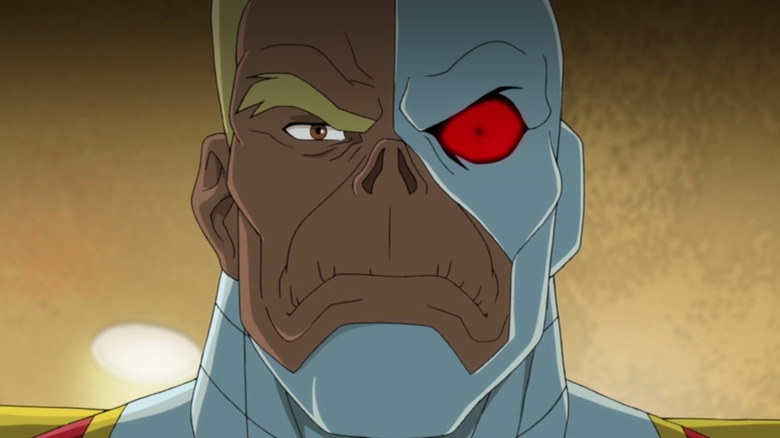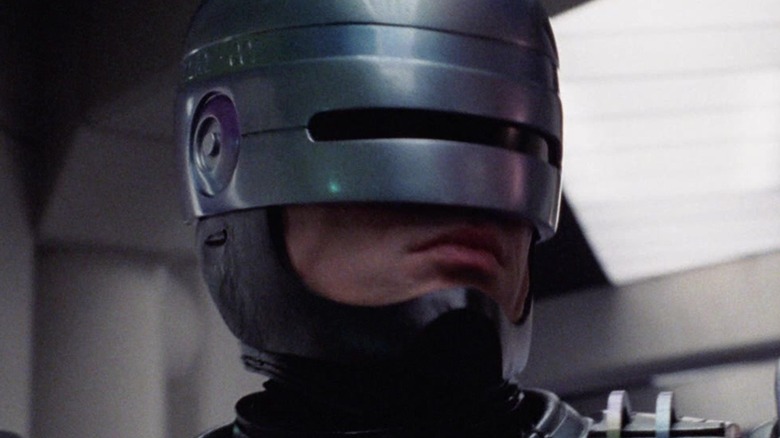Why Terminator, Robocop, And Escape From NY All Owe A Debt Of Gratitude To Marvel's Deathlok
In the 1970s, writers Doug Moench and Rich Buckler created Deathlok, a hero who was unlike the crusaders, gods, and adventurers that littered the pages of Marvel comics at the time. Introduced in the pages of "Astonishing Tales," Deathlok occupied the grey area between good and evil. The character was inspired by sociopolitical paranoia following the Watergate scandal, as well as society's fear of technological advancements and other issues of the day. His adventures took place in a bleak future where war had devasted the world and cyborg assassins were the norm. Unfortunately, the "Deathlok" comics were too ahead of their time to be fully appreciated back then, but their influence did seep into some hit movies.
"Deathlok" tells the story of Luther Manning, a United States army colonel who gets killed by a concussion mine in 1985. However, Manning and his military prowess are too good to waste on death, so his old commander, Simon Ryker, resurrects him as a cyborg super soldier known as Deathlok. Ryker has nefarious plans to replace humanity with cyborgs, but he doesn't count on his creation going off the rails. Despite being a programmed patchwork of flesh and wires, Manning regains his old memories and proceeds to make it his mission to defeat Ryker.
The "Deathlok" comics have since gone on to revolve around new protagonists with different creative teams at the helm. However, the original series' ideas and themes have informed some of the most notable sci-fi action films out there, and it's about time people recognized that.
A time-traveling Deathlok story predates The Terminator
James Cameron's failed "Spider-Man" movie indicates that he used to be interested in Marvel stories. Therefore, it's reasonable to suggest that he was familiar with "Deathlok" in the 1970s and early '80s given that some of its ideas can be found in "The Terminator."
Released in 1984, "The Terminator" follows a cybernetic assassin who gets sent back in time to kill a woman whose future son will lead a resistance against an evil network that wants to exterminate the human race. However, it wasn't the first sci-fi story to pit cyborgs in a story about time travel. J. M. DeMatteis' "Captain America: Deathlok Lives" — which is essentially a "Deathlok" story that expands upon Moench and Buckler's comics — introduced a similar concept one year earlier. In this one, a clone Manning gets sent back in time from the year 1991 to locate Deathlok, only to be slain by the cyborg assassin.
Per Den of Geek, Cameron previously stated that "The Terminator" was inspired by his own nightmares. Of course, it's possible that reading "Captain America: Deathlok Lives" is what caused the director to have these dark dreams in the first place.
Deathlok provided the blueprint for RoboCop
Paul Verhoeven, Edward Neumeier, and Michael Miner haven't gone on record to discuss the influence that "Deathlok" evidently had on "RoboCop." That said, the similarities between both cyborg stories are undeniable. Broadly speaking, "Deathlok" and "RoboCop" are both inventive plays on Mary Shelley's "Frankenstein" concept, which paved the way for all stories about madmen creating reanimated monstrosities to do their bidding. More specifically, though, "Deathlok" and "RoboCop" center around fallen family men who were brought back from the dead by evil corporate-military regimes and upgraded with cybernetic parts. Eventually, both cyborgs rediscover their humanity and rebel against their respective makers. The only major difference between them is that RoboCop is a law enforcement officer and Deathlok is a soldier.
Furthermore, "Deathlok" and "RoboCop" are action-packed satires that take aim at capitalism, technology, authority, right-leaning politics, and the military-industrial complex. Granted, there are countless sci-fi stories that explore these themes, and "Deathlok" wasn't the first one to do it. But consider this: Verhoeven once described "RoboCop" as a "Christ story" in an interview with MTV. "Deathlok," meanwhile, was informed by biblical storytelling back in 1974, as "Astonishing Tales #26" opens with the cyborg being crucified in a laboratory.
Perhaps the parallels between "Deathlok" and "RoboCop" are coincidental. At the same time, there are enough of them to suggest that Verhoeven and co. were inspired by Marvel's monstrous cyborg when they conceived their own sci-fi masterpiece.
Deathlok turned the Big Apple into a jungle before Escape from New York
The original "Deathlok" comics take place in a futuristic New York City that's riddled with crime, poverty, corruption, and societal collapse. The gritty dystopia is basically a warzone populated by goons, cannibal gangs, and the various agents, soldiers, and cyborgs whose mission is to kill Deathlok. Similar themes would later find their way into John Carpenter's "Escape from New York," which also deals with a wronged hero in a futuristic world gone mad.
Released in 1981, "Escape from New York" portrays the Big Apple as a lawless prison in which all of the criminals are left to rot and fight amongst themselves. The setting echoes the New York wasteland in the "Deathlok" comics, albeit without the Marvel elements. Additionally, the protagonist of Carpenter's film, Snake Plissken (Kurt Russell), is a rogue soldier who was also used as a pawn by military types, similar to Manning. Thematically, both stories are concerned with corruption, exploitation, and societal regression.
Like the early "Deathlok" comics, "Escape from New York" was a reaction to the Watergate scandal and the mood of American society at the time. Carpenter was also inspired by Michael Winner's controversial "Death Wish" movie for the way it presented New York as a dangerous concrete jungle (per It Came From...). However, there's no denying that "Deathlok's" bleak vision of the future laid the foundations for movies like "Escape from New York" to build from.



